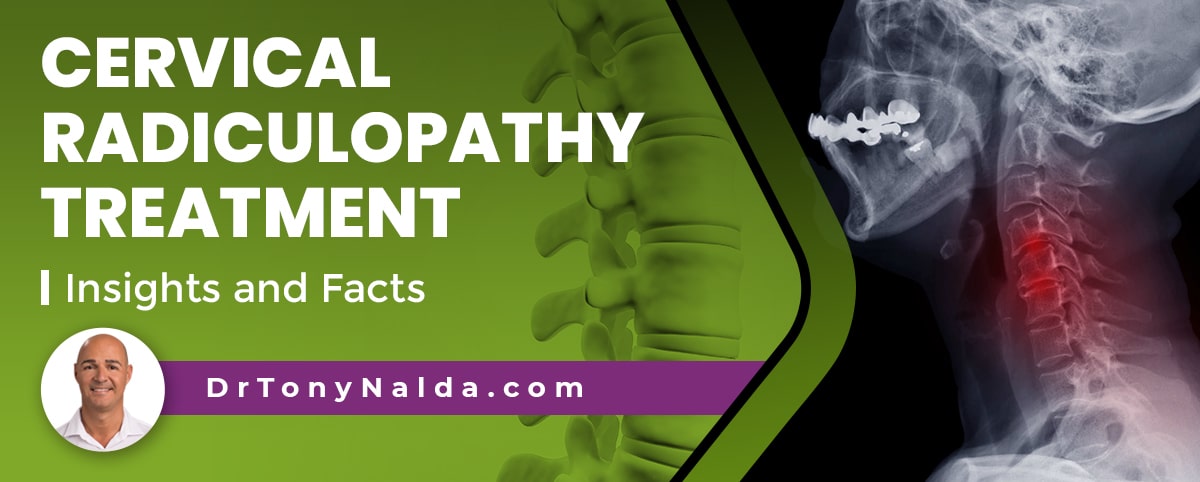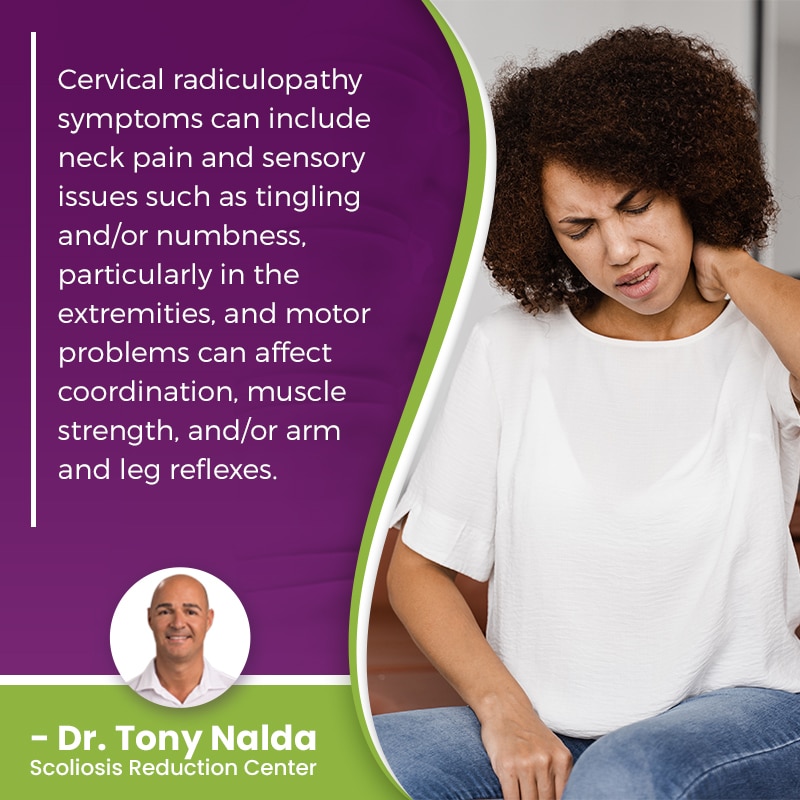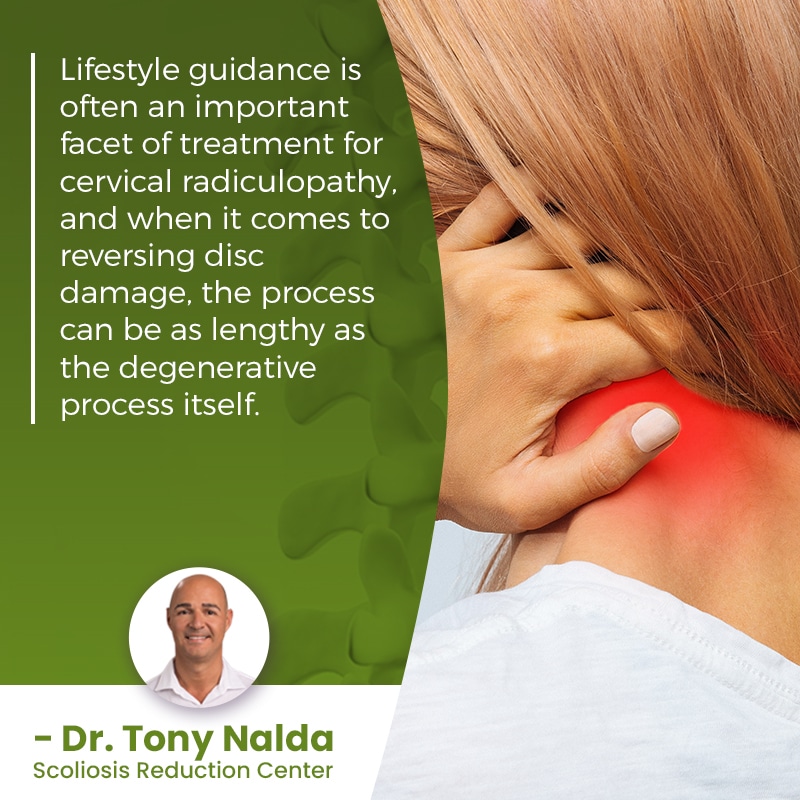Cervical Radiculopathy Treatment: Insights and Facts

The spine is one long structure with different sections that play unique roles in preserving spinal health and function. Each section is unique, but also affected by the health of the other spinal sections. In most cases of spinal conditions/issues, the area of the body located closest to the affected nerve root is going to feel the majority of its direct effects, so cervical radiculopathy is going to mainly affect the upper body.
There are three main spinal sections, and the cervical spine refers to the neck. Cervical radiculopathy is diagnosed when one or more nerve roots in the cervical spine are compressed and irritated, commonly impacting the affected nerve's neurological function and causing pain.
Before getting to the specifics of cervical radiculopathy treatment, let's first explore some basic spinal anatomy.
Table of Contents
The Spine: Function and Structure
The spine is an essential structure; not only does it allow us to stand upright and practice good posture, it also protects important organs, facilitates a wide range of flexible movement, and the spinal cord within works with the brain to form the body's central nervous system.
A healthy spine is curved, but in the right places, and in the right amounts; scoliosis involves the development of an unnatural sideways-bending and rotating spinal curve.
The spine's natural curves make it stronger, more flexible, and better able to absorb and distribute mechanical stress incurred during activity.
If the spine loses one or more of its natural and healthy curves, this means its vertebrae are no longer aligned as they should be to function optimally, and a misaligned spine introduces a lot of uneven forces to the spine, its surrounding muscles and nerves, and the entire body.
The spine consists of vertebrae (bones) stacked on top of one another in a straight and neutral alignment, and adjacent vertebrae are separated by an intervertebral disc.
The spinal discs are key to spinal health and function, including spinal nerve health and function; they act as the spine's shock absorbers, provide adjacent vertebrae with cushioning so friction isn't generated during movement, combine forces to facilitate flexible movement, and give the spine structure (adjacent vertebrae attach to the disc in between).
If a disc shifts its position or changes shape, this can mean taking up more space within the spinal canal, through which the spinal cord, containing 31 pairs of spinal nerves, passes, and this type of nerve compression can cause a number of symptoms, largely related to the location of the affected nerve root.
The Cervical Spine
There are three main sections of the spine: the cervical spine (neck), thoracic spine (middle/upper back), and the lumbar spine (lower back).
Each spinal section has unique responsibilities that make it vulnerable to different issues, and when it comes to the cervical spine, posture is important; it's estimated that if the neck's posture shifts forward as little as one inch, the weight of the head on the neck increases by approximately 10 pounds.
It's said that everyone will experience lower back pain at some point in their lives, and this is because the vertebrae of the lumbar spine have to support the weight of the spinal sections above, the entire trunk, and they feel the effects of bending, lifting, and twisting motions.
The thoracic spine is the largest spinal section, making it vulnerable to a number of spinal conditions/issues, and the cervical spine is the bridge between the brain and the rest of the body.
In addition, the cervical spine also has the task of supporting the weight of the head and facilitating the neck's ability to turn the head from side to side and up and down.
The C5 and C6 vertebrae are commonly referred to as the stress vertebrae because of the strain of supporting the weight of the head and neck, and in the modern age, tech neck is a very-real problem that exposes the cervical spine to adverse spinal tension.
There are openings in the vertebral bodies (foramen) through which the nerve roots pass and extend to different areas of the body, but what happens if one of those nerve roots is irritated and becomes a pinched nerve?
What Is Cervical Radiculopathy?
Compression is uneven pressure, and if a nerve root in the cervical spine is exposed to uneven pressure, it can become irritated, inflamed, and/or impinged, and this can vary in severity and cause a number of symptoms.
The nerves of the cervical spine send messages between the brain and the body's muscles, shaping their reflexes.
If a nerve in the cervical spine becomes a pinched nerve, it can cause symptoms felt anywhere along the nerve's pathway, which can be extensive.
As nerves are like branches of a tree, fanning off in multiple directions, pain can be felt far from the affected nerve's site of origin, and this can include pain that radiates into the neck, arm, chest, shoulders, upper back, and the hand; in most cases of nerve compression, its effects are felt largely on one side of the body.
 Cervical radiculopathy symptoms can include neck pain and sensory issues such as tingling and/or numbness, particularly in the extremities, and motor problems can affect coordination, muscle strength, and/or arm and leg reflexes.
Cervical radiculopathy symptoms can include neck pain and sensory issues such as tingling and/or numbness, particularly in the extremities, and motor problems can affect coordination, muscle strength, and/or arm and leg reflexes.
Cervical Radiculopathy Treatment
When it comes to treating cervical radiculopathy effectively, this means first determining its underlying cause so an effective treatment plan can be customized.
The most common cause of cervical nerve roots being compressed is spinal degeneration, and this can include natural and age-related and/or the cumulative effect of certain lifestyle choices.
As we age, the spine, like the rest of the body, is subject to degeneration, and it's most often the spinal discs that are the first structures to feel the effects of degeneration.
Lifestyle factors that can affect a person's level and rate of spinal degeneration include carrying excess weight, leading a sedentary lifestyle, chronic poor posture, excessive consumption of alcohol and/or smoking, and repeatedly lifting heavy objects incorrectly.
In most cases of spinal degeneration, it's degenerative disc disease that's the cause as the discs can dry out as we age, becoming desiccated, change shape, and compress its surroundings, including muscles and nerves.
Lifestyle guidance is often an important facet of treatment for cervical radiculopathy, and when it comes to reversing disc damage, the process can be as lengthy as the degenerative process itself.
 Condition-specific chiropractic care can help relieve pressure off discs and nerves if they are caused by vertebral subluxation, as with scoliosis, through a series of techniques and manual adjustments that work towards realigning the spine.
Condition-specific chiropractic care can help relieve pressure off discs and nerves if they are caused by vertebral subluxation, as with scoliosis, through a series of techniques and manual adjustments that work towards realigning the spine.
Physical therapy can also help improve posture, body positioning, increase core strength so the spine is better supported by its surrounding muscles, and certain exercises can also help stimulate specific areas of the brain for enhanced brain-body communication.
Alternating hot/cold therapy can also help with pain relief as applying cold to the neck can help reduce pain and inflammation during an activity flare up, and hot therapy can help keep the spine and neck/shoulder muscles loose and relaxed to prevent strain/injury.
Treatment of cervical radiculopathy occurs when the condition is causing noticeable symptoms and/or functional deficits, and while prescription medications and steroid injections can help with short-term pain relief, the nerve root compression itself has to be addressed for any type of long-term improvement to chronic neck pain and/or related muscle weakness.
If nerve root irritation is left untreated and the underlying cause is not addressed, the nerve can become permanently damaged, and that type of damage is often irreversible: something we want to work proactively to avoid.
Conclusion
Cervical radiculopathy treated proactively is shaped by the cause of the nerve compression, its severity, and the symptoms it causes.
The vertebrae of the cervical spine are important; they have to support the weight of the neck, the head, and enable the neck/head's range of motion.
Nerves need space to function optimally within, and if a nerve in the cervical spine is exposed to uneven pressure, it can become irritated, inflamed, and/or impinged; impingement typically produces neck pain and arm pain.
Traditional surgical treatment can be risky and invasive, and many patients with cervical radiculopathy can be treated successfully with nonsurgical treatment.
Here at the Scoliosis Reduction Center, I have experience treating a wide range of spinal conditions/issues, and when it comes to addressing symptoms of cervical radiculopathy, this involves determining the underlying cause and customizing treatment plans accordingly.
Oftentimes, a combination of condition-specific physical therapy and chiropractic care can help to preserve disc health and function and remove pressure off an affected cervical nerve root(s).
Dr. Tony Nalda
DOCTOR OF CHIROPRACTIC
After receiving an undergraduate degree in psychology and his Doctorate of Chiropractic from Life University, Dr. Nalda settled in Celebration, Florida and proceeded to build one of Central Florida’s most successful chiropractic clinics.
His experience with patients suffering from scoliosis, and the confusion and frustration they faced, led him to seek a specialty in scoliosis care. In 2006 he completed his Intensive Care Certification from CLEAR Institute, a leading scoliosis educational and certification center.
About Dr. Tony Nalda
 Ready to explore scoliosis treatment? Contact Us Now
Ready to explore scoliosis treatment? Contact Us Now





